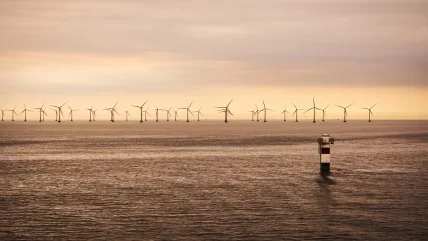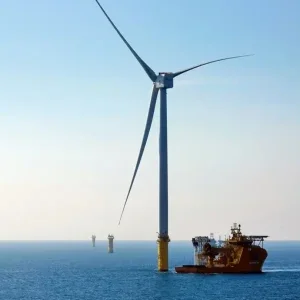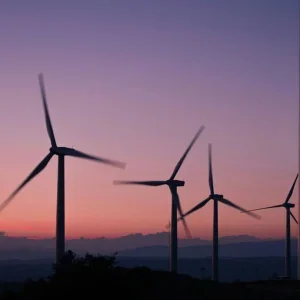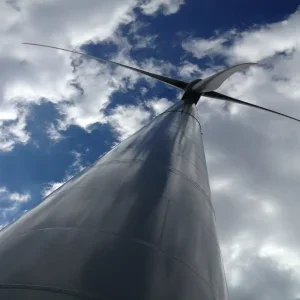
Over the past few decades, few things have become associated with the green revolution as closely as wind turbines. In a place like the UK, gusts and breezes now contribute around 25% of the country’s energy mix, with a potential future Labour government promising to quadruple capacity by 2030. Nor is the island nation alone.
In May, for instance, four of Britain’s North Sea neighbours announced an ambitious plan to boost their wind portfolio. By the middle of this century, Germany, Belgium, Denmark and the Netherlands promise to build at least 150GW of soaring offshore turbines, transforming the region into a “green power plant” for Europe. Yet, if wind turbines are quickly securing a place in the hearts of policymakers and laymen alike – 77% of people in the US now support building more towers, according to a 2021 Pew Research Centre survey – they could soon become even more important.
This potential can be understood in two simple words: green hydrogen. By dovetailing wind farms with hydrogen manufacturing, operators hope to abandon old techniques and produce hydrogen cleanly and efficiently, at a stroke transforming industrial processes and offering users a genuinely sustainable way of sourcing the molecule. At its most successful, indeed, green hydrogen could do much to save the planet at large – vital if we’re going to avoid a 2°C rise in global temperatures.
Even so, this brave new world is far from straightforward. Though tests and prototypes are well underway, it remains to be seen how green hydrogen will fare when production is ramped up. Then there’s the question of demand. Though hydrogen is an industry stalwart, advocates hope to broaden its popularity, liaising with governments and municipalities to fill everything from taxi cabs to steel plants. But for that to happen, attitudes towards energy planning need to change and robust infrastructure needs to be able to transport molecules from offshore turbines to wherever they’re required. With a bit of support from politicians, however, green hydrogen could soon be as popular as wind energy – and potentially even more reliable.
Coming up for err
Hydrogen is a crucial part of the global economy. Around 75 million tonnes are produced globally each year, employed everywhere from refining petroleum to treating metals to manufacturing products like electronics and glass. As some of these examples imply, the hydrogen sector has traditionally not been especially clean – and that’s before you consider how it’s made. “To produce a ton of grey hydrogen, you emit like 10t of CO2,” says Poul Skjaerbaek, the chief innovation and product officer at Siemens Gamesa Renewable Energy. As Skjaerbaek explains, that colossal figure can fundamentally be understood in terms of chemistry. Historically refined from fossil fuels gas and coal – themselves made from carbon and hydrogen – the process produces carbon leftover. That carbon, Skjaerbaek continues, reacts with oxygen in the air, resulting in mountains of climate-damaging CO2.
Altogether, old-fashioned hydrogen manufacturing is estimated to produce 830 million tonnes of CO2 each year – almost as much as the whole of Germany – while about 6% of all natural gas consumption is taken up by hydrogen production. But perhaps even more frustrating than these headline figures is that an alternative to fossil-based hydrogen is theoretically available. As Skjaerbaek stresses, scientists have, for over a century, understood that hydrogen can also be made with water electrolysis. The problem, however, is that producing the necessary electricity has typically required fossil fuels – quickly negating whatever environmental benefit electrolysis could have offered.
That, of course, is no longer true. With individual offshore turbines now able to produce up to 74GWh – as is the case with GE’s Haliade-X 14 MW turbine – and the biggest offshore farms capable of powering a cool 1.3 million homes, clean electricity is a reality across Europe and beyond. That, in turn, offers new space for electrolysis-based hydrogen manufacturing. “Placing hydrogen electrolysers on offshore wind turbines is likely to be the quickest and cheapest way of providing fossil-free hydrogen at the scale needed to reduce emissions from heavy industries such as steel and chemicals,” stresses Danielle Lane, Vattenfall’s UK country manager, adding that there’s a real urgency to produce “large quantities” of fossil-free hydrogen.
Appreciate the market and this last comment makes sense. For starters, the need for hydrogen in traditional chemical or electronics manufacturing isn’t going away. According to work by the World Bank, the hydrogen production market is already worth $130bn and is expected to rise by 9.2% per year through the end of the decade. That’s shadowed by the rise of new hydrogen-heavy industries too. Between hydrogen-powered cruise ships and hydrogen-powered planes, Lane argues the molecule is “set to play an important role as we move to net zero”. More to the point, Lane adds, industry needs to get ahead of the game, mapping out development and delivery processes even as temperatures continue to rise. Considering 95% of hydrogen production continues to involve fossil fuels, she may well have a point.
Brande new
Brande is probably not the first spot you’d expect to find the offshore hydrogen revolution. Just look around you: Brande is in the middle of rural Denmark, with nary a wave or a shoreline in sight. But explore the site, some 160 miles from Copenhagen and 30 from the sea, and you’ll soon realise how impressive the project really is. Developed by Skjaerbaek and his team at Siemens Gamesa Renewable Energy and bolstered by a one-off permit from the Danish government, it involves connecting an electrolyser to an existing onshore turbine.
The point, explains Skjaerbaek, is to “demonstrate that we can generate green hydrogen directly out of a turbine” – before eventually expanding the concept to offshore turbines off the Danish coastline.
77%
The percentage of people in the US that support building more wind turbines, according to a 2021 survey.
Pew Research Centre
$130bn
The value of the global hydrogen market in 2022, which is expected to rise by 9.2% per year through the end of the decade.
World Bank
“Hydrogen has great potential to decarbonise industry and we’re working on a new steel-making process that will eliminate CO2.”
Danielle Lane
530 million
The predicted global demand for tonnes of green hydrogen by 2050.
PwC
By any measure, you have to think the Brande experiment is going well – apart from proving the scalability of Siemens Gamesa’s electrolysis system, some of the resulting hydrogen has ended up powering Copenhagen taxis. Nor is it the only place that energy companies are finding success with green hydrogen. Off the Dutch coast, for instance, is Hollandse Kust West. As part of a new wind farm at the site, Vattenfall is planning on equipping a trio of wind turbines with electrolysers. Working together with transformers and batteries, the resulting hydrogen will then be sent via pipeline to the port of Rotterdam, where it’ll finally be integrated into Europe’s hydrogen network.
Between them, the Dutch and Danish projects are part of a broader transformation of the world’s hydrogen portfolio. Though things are admittedly starting from a low ebb, PwC reports that global demand for green hydrogen could reach 530 million tonnes by 2050, along the way displacing the equivalent of around 10.4 billion barrels of oil. Not that any of this is simple. For one thing, the Brande experiment only worked because Siemens Gamesa secured a special dispensation from the Danish state, absolving them from paying to use the grid as they ran electricity from the turbine into the electrolyser.
And as Skjaerbaek explains, technology was another issue. “When the hydrogen comes out of the electrolyser, it’s around 35 bar, depending on what technology you use,” he says. “You cannot really transport hydrogen at that pressure because it fills a lot of space.” To get round this difficulty, Siemens Gamesa partnered with a hydrogen distribution company, developing a “joint system” to compress the hydrogen down and actually get it to the end consumer. Lane, for her part, is similarly conscious of the question of storage, noting that Vattenfall was recently involved in converting a Swedish cave into a green hydrogen storehouse. Inaugurated this summer, the facility at Luleå could eventually help cut Sweden’s carbon dioxide emissions by a tenth.
Pipe dreams?
What, then, does the future of green hydrogen look like? Certainly, the technology is there to be adopted – and schemes like Hollandse Kust West suggest green hydrogen could soon be coming to a factory near you. At the same time, Lane envisages even more exciting uses for the molecules. “Hydrogen has great potential to decarbonise industry and we’re working on a new steel-making process that will eliminate CO2,” she says, adding that the scheme, of which the Luleå project is part, will ultimately remove environmentally disastrous coking coal from the steel manufacturing process.
Skjaerbaek basically shares this optimism. Especially given Europe’s increasingly precarious energy outlook, he argues that the continent needs to “accelerate” its transition towards solutions like green hydrogen. That’s especially true, he continues, given the potential efficiencies of hydrogen even compared with other types of green energy. Though wind energy is clearly an improvement over coal or gas, he stresses that you’re still transporting the resulting electricity over relatively inefficient copper cables. But if politicians have the foresight to build the right infrastructure, Skjaerbaek suggests you can “generate hydrogen directly and put it into a pipe, where you have very low losses”. Given how quickly the planet is heating up – and how soon Europe’s energy reserves may begin to run dry – you have to hope they’re listening.






